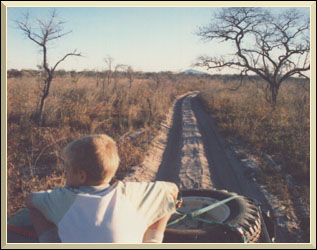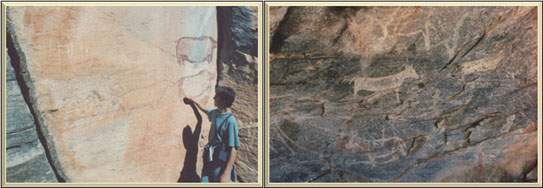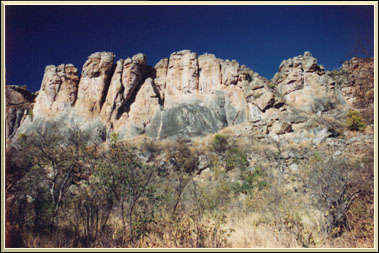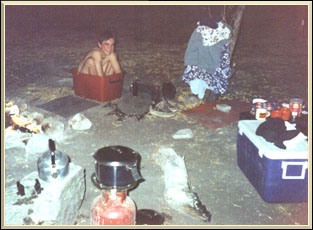|
|
|
The Tsodilo Hills are one of the most rewarding destinations in Botswana. In contrast with the Okavango Delta, there is no water and only big game are those painted on the rocks, but apart from the incredible paintings, there is a certain atmosphere that enshrouds these hills, an atmosphere that lures one to return again and again.
We left the Aha Aha Hills early but the going was slow back to the main tar road at Nokaneng and from there to Etsha 6. We followed the gravel road along the Okovango Delta in hope to gain some vision of the water but the road was to far away from the delta. Eventually we reached Etsha 6, a small village with a petrol pump, Police station, school and some buildings acting as shops with very little stored inside. We filled the diesel tanks but we needed more water as the 65 liter tank on the roof was near empty. At most fuel stations in South Africa you will find a water tap but not at Etsha and with some difficulty and directions we found a tap about 200 meters away.
Along the gravel road towards Etsha 6 we've seen small square and about 1 meter high constructions, not realizing they were water points. The small walls prevent cattle and donkeys to get close to the water taps therefore the immediate area around the water tap is free from mud and clean. The water containers were filled and we were off towards the tar road from where we will find our way to Tsodilo Hills.
A few weeks before our journey my eldest son's, Pieter, Sunday School teacher visited Tsodilo and he told Pieter that we should take the middle road towards Tsodilo as the bottom road is terrible. So we did, on the map it was 10 km shorter than the bottom road but it was sandy and the going was very slow with a maximum speed of 21,5 km/h!
 Soon
the hills made their appearance on the horizon and as the sun was about
to set, we were on a great sand dune with the majestic "Male Hill" on our
right. As we engaged to low gear for the decent, I was wondering about
the return journey because the sand was thick and soft. There was no problem
with the decent and soon we ask for direction to the Monument attendant's
office.
Soon
the hills made their appearance on the horizon and as the sun was about
to set, we were on a great sand dune with the majestic "Male Hill" on our
right. As we engaged to low gear for the decent, I was wondering about
the return journey because the sand was thick and soft. There was no problem
with the decent and soon we ask for direction to the Monument attendant's
office.
There are a number of campsites but few are marked as such and you just hope that you are camping "legally".
We've reached the first camp site well after sunset. There were three other vehicles and we were searching for a spot to camp when a fellow adventurer approached me to inform me of a much better camp site which is better protected against wind a little further away towards the foot of the female hill. I thanked him and in the bright lights of the Land Rover (440 watts) we've reached the spot well situated underneath a big tree and surrounded with smaller trees.
Quickly the tent was up, coffee water was boiling and the fire was ready for a great braai. The stars were so bright and with no moon, the stars made it possible to walk around without a flashlight or as I know it: a torch.

The next morning we were very surprised to see our first rock painting of an elephant next to our tent. We packed our day bag and started to follow the Rhino trail, which goes through our camp site.
There are five definite trails on the male and female hills. These trails take you closer to some great rock paintings and it is believed that the paintings were probably done by the ancestors of the Boesman, or the "San". There are also evidence that the black people lived in these hills as there are a few Iron and Stone Age sites in the hills.
There are no large game to seen in the area, but we did cached the odd glimpse of a Steenbok. There are however, many smaller interesting creatures such as the Rock monitor, which is a dry land lizard with a rounded snout compared to the Water lizard. Another unique creature is the Tsodilo Hills Rock getto which gave us great amount of entertainment at our camp.
 The
following afternoon we followed the track around the female hill and discovered
many great camping sites. Our main purpose was to find the natural well
just below the cliffs which holds water all year round. It is believed
by the locals that a serpent with horns like a Kudu lives in the well and
that one can not pass the well without throwing a stone into the water.
This will keep the serpent happy and prevent him from attacking you.
The
following afternoon we followed the track around the female hill and discovered
many great camping sites. Our main purpose was to find the natural well
just below the cliffs which holds water all year round. It is believed
by the locals that a serpent with horns like a Kudu lives in the well and
that one can not pass the well without throwing a stone into the water.
This will keep the serpent happy and prevent him from attacking you.
We found the Cliff Trail close to the cliffs of the Female Hill and followed it towards the cliff and a few meters up there was this hole, filled with water. The boys were very eager to climb to the top of the cliff and as we only had 1 hour sun left we decided to climb for 30 minutes and then to turn back. We've reached the summit and the view was fantastic and as we climb down the cliff we saw the most beautiful sunset. It was a great day.
Back at the camp, it was time for our first bath with boiled water.  The
big red tub was the bath and it was great to take a bath next to the camp
fire!
The
big red tub was the bath and it was great to take a bath next to the camp
fire!
The Tsodilo Hills consist of four hills, lying roughly in line. The biggest comes into view first when approaching the hill complex. The Boesman refer to the biggest hill as the male, the smaller one next to it the female and the next in line the child. The fourth hill is removed from the others and is not named. Legend has it that the fourth hill is the male hill's first wife, whom he left for a younger wife and she is now lurking in the background.
An amazing 3500 individual rock paintings have already been discovered and described in the Tsodilo Hills and no doubt there will be more. Our time was up and we had to leave this wonderful place. To full days was far to short, you need a week to explore the hills and visit the wonderful rock paintings.
We followed the road between the Female and Male Hills towards Shakawe and it was not near so sandy as the road to Tsodilo but never the less, the going was slow. We exit Botswana through Mohembo border post on our way to Etosha National Park.
One day I will return to stay much longer, to visit the wonderful rock painting sites and to experience the silence of the Kalahari.